It might seem odd that I am writing about extra toes. Typically, hand surgeons don’t take care of the foot but, in many situations, the hand surgeon is the perfect person to help take care of certain foot problems including extra toes, toe syndactyly (toes joined together), and even things like cleft foot. The reason I feel that the hand surgeon can help with certain foot problems is pretty clear- the foot issues are similar to the hand problems and the reconstruction techniques are very similar. This not to say that there are plenty of great pediatric orthopedic surgeons who can care for toe and foot issues like these, because there certainly are.
I have previously blogged about extra toes- find that
here. I hope to also post about toes on the outside of the foot- there are a bit easier to address and less critical for balance and walking.
It is key that the big toe be as sound as possible with reconstruction. We want to create the right sized digit (i.e., one that won’t cause problems wearing shoes) that has good motion and is stable. To me, this is very similar to reconstructing the extra thumb as the goals are similar and the thumb and the great toe are critically important to hand and foot function. The timing is debatable. Some surgeons chose to operate before the child really starts walking as it makes the recovery easier while other wait longer as the toes get larger (and operate at 18-24 months). I prefer to operate before walking but there are a number of factors to consider and discuss with each family.
Surgically, the reconstruction involves the following:
1) The skin. We need to create a great toe that is not tensioned by the skin immediately or in the future (from scarring).
2) Removing the extra toes. Ideally the smaller toe or the toe with greater challenges from a bony or ligament standpoint. Sometimes, as in this case, the toes are relatively equal and this decision is not quite as straightforward but typically we remove the inner toe.
3) Stabilize the remaining toe to create good ligaments
4) Make sure the remaining toe is as straight as possible and is well set up for growth in the future. There is always a chance that there will need to be a surgery later but hopefully it can be avoided if we get good balance with the first surgery.
5) Address the toenail. This can be quite challenging with conjoined nails but the goal is a well balanced toe with good nail support.
I typically cast for about 5 weeks and often use a pin to stabilize the healing toe. That pin is removed at the time of cast removal. Here is a case example. The x-rays are particularly interesting as there are delta phalanges on both sides- that is the bones are not the typical rectangular shape but are curved which can indicate an abnormal growth plate. This may be corrected at the initial surgery.
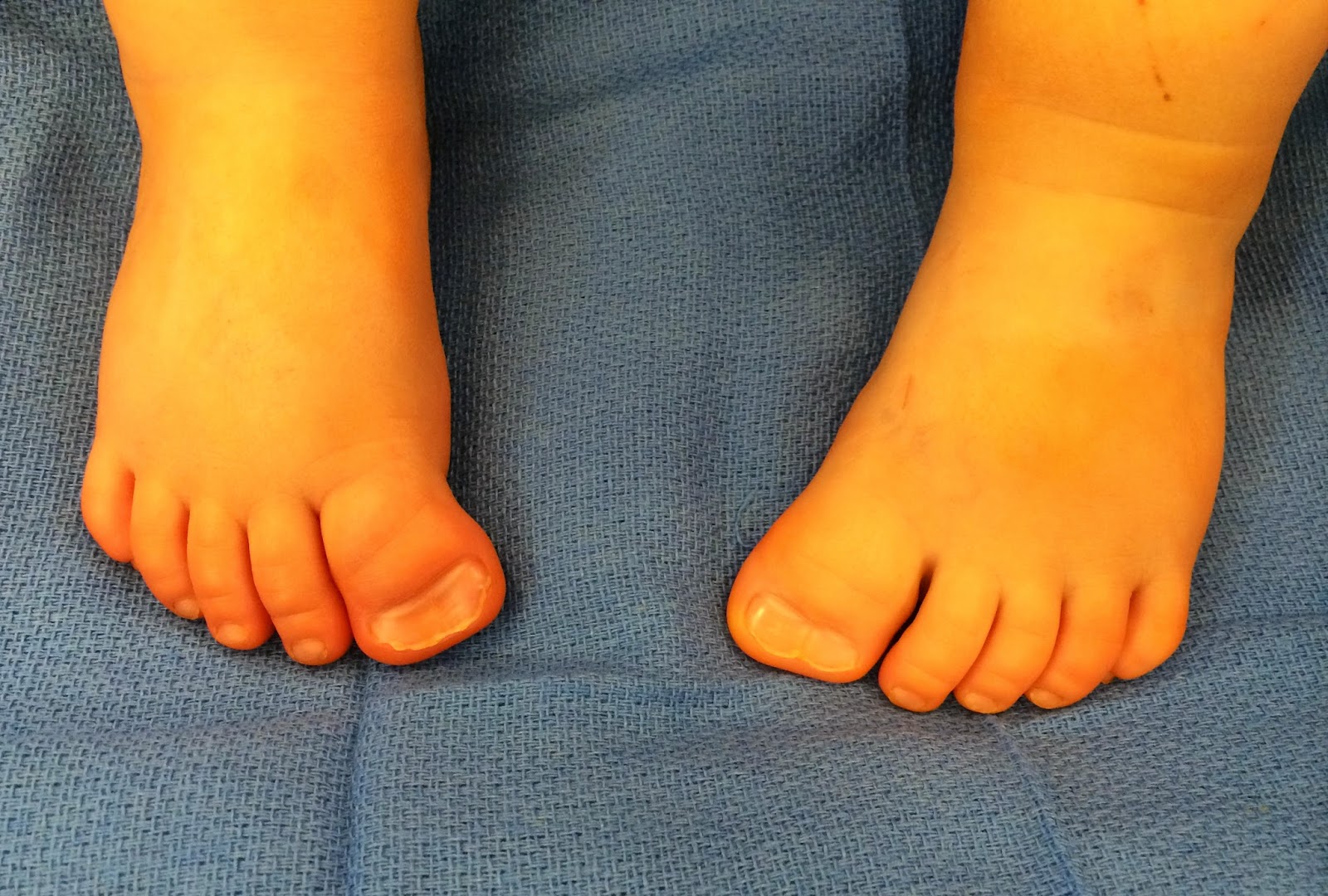 |
| Extra great toes with conjoined nails (synonychia is the technical term). Note that there is some deviation of the toes. |
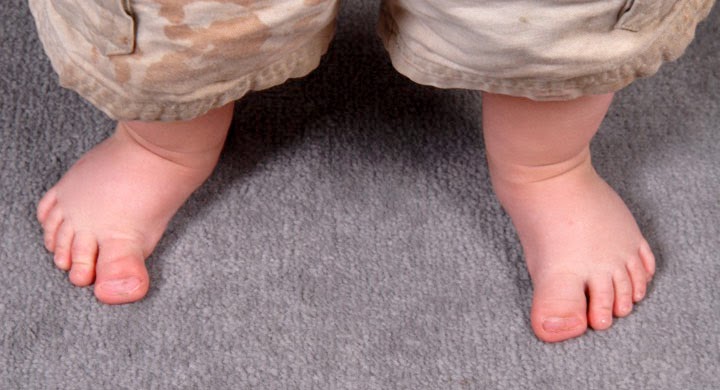 |
| Weight bearing with even more deviation noted in the extra great toes. |
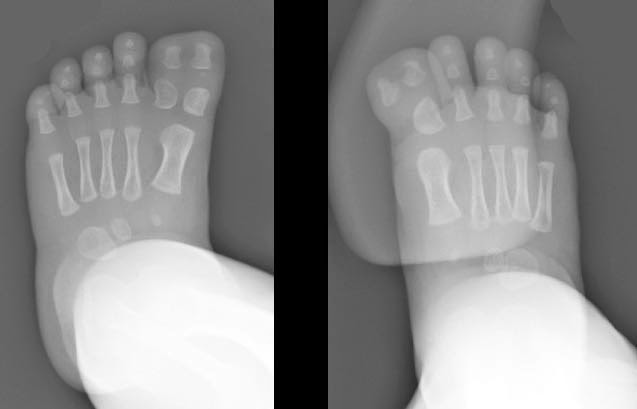 |
| X- rays of the extra great toes. Note that the feet are different. |
3 months after surgery. The child is walking well and the family is very pleased.
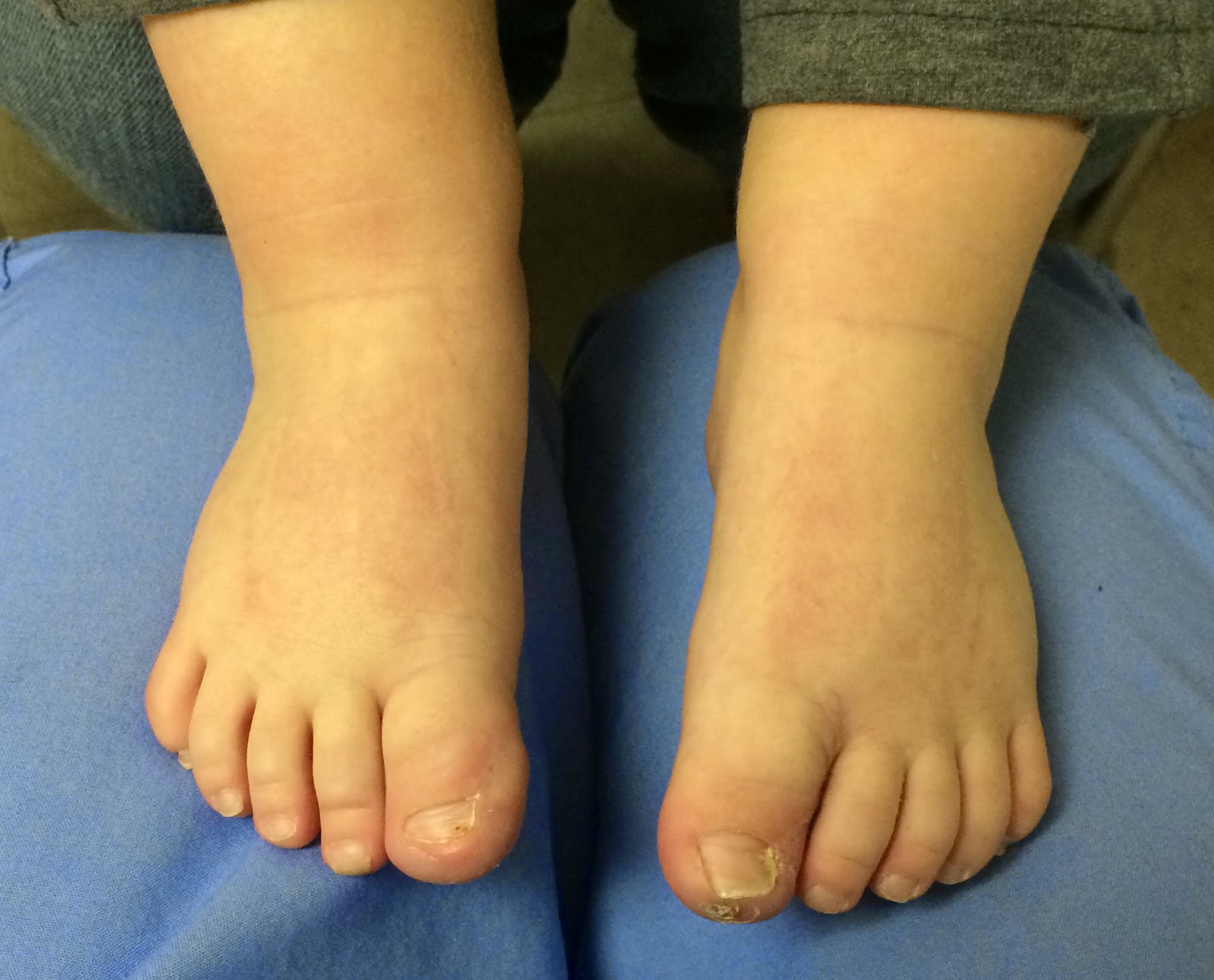 |
| Great toes after reconstruction. Excellent alignment has been achieved. The nails are imperfect. |
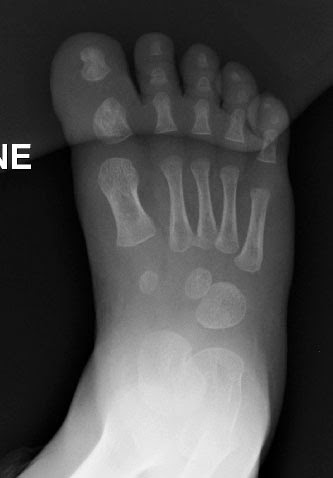 |
| Great toe after reconstruction. Right. |
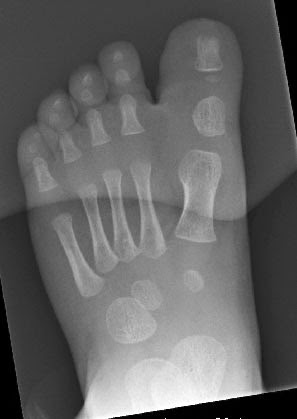 |
| Great toe after reconstruction. Left. |






hello. I was wondering if you had to do follow up surgery on your patience with this condition. My daughter was operated on for the same condition 18 month old. Now that she is 7 years old she is not only complaining of great pain and her baby tell but it seems to be bending inward and creating a protuding bunion.
futhermore, have these patients needed further surgery and/or treatment as they reach full maturity, say at the age of 18 and over? many thanks!
Chitown Momma,
Thanks for your question. Only rarely have we had to perform followup surgery in this situation but certainly that need can occur and, when required, can be helpful. The goal with any surgery is to align the toes (and growth plates) to allow future growth without the need for additional surgery down the road. But, you are correct, surgery can be required all the way to the time of skeletal maturity (maybe aged 14) but hopefully not after.
Hello, and thank you for the information concerning "synonychia", of which I have on both feet. I haven't had any surgeries to correct them, though I have always thought about it. I'm almost 50 now, so I don't see need to do so now. Thanks again : )
My daughter had corrective surgery at the age of 6 months. She is now almost 3, and her toes are kind of a mess. I wish I wouldn't have trusted the one and only orthopedist we consulted so quickly. We are now seeing a podiatrist and know she will need at least 2 follow-up surgeries. On top of a lot of extra tissue left, leaving very bulky toes, they are "tethering" b/c of the scars. There is also extra bone still left that will need to be cleaned out. She walks quite "flat-footed" and I have to think her toes play a role in that.
I have googled polysyndactyly, Griegs Syndrome, etc. a million times and am just now finding this page. Wish I would have found it sooner! Wish you could have worked on my daughter…the results above are astonishing!!!
I’m sorry to hear about that! Has she had orthotics or specials shoes since your post? My twin and I were born with polysyndactyly and had surgeries. I had three total and the feet do get better over time. I’m 32 now. Had surgery around 18 months, 3 and 5. We wore corrective shoes until about 10. My feet look decent now and no one would even know. It wasn’t until I fractured my foot in 2018 that I saw what remained of my other toe (a tiny metatarsal) and actually believed my parents that I had an extra digit. I just thought my big toe was deformed. The scarring will get lighter over time…but I couldn’t imagine the tethering. See a specialist. My parents/ md did not have me wear cramped shoes EVER. My twin’s big toe curled a bit from issues with shoes and the scarring. I hope for the best for you and your daughter.
Angi,
Good luck with your daughter. Sometimes more time can help things but it is really important to find a surgeon with experience in this particular area (at the first surgery and now). The growing foot is not the same as the adult foot- usually pediatric orthopedic surgeons are the best ones to help in this area. And, as you know, every child is different so it is difficult to compare the pictures above with your daughter (but thank you very much).
What age did you do this surgery? And l, what age would you recommend this surgery done? My daughter has one on her right toe and right ring finger. She's 8 months old now. Thanks.
You daughter is 10 months now and is a candidate for surgery. The timing for the foot may be affected by weight bearing age and so sometimes we aim for surgery at the 9-10 months age although older kids can do just fine. And the hands presumably can be treated at a similar time.
Hello Charles. My daughter is 2 years old and has the same problems that looks in these pictures. She dont have any problems to walk and run. But I think that the problems will be to wear shoes in the future. We have to buy shoes 1 or 2 size more large. Is necessary the surgery. Is urgent or we can spect to talk with her when she will be 6 or 7 years old about the surgery.
Shoe wear and social issues are the challenges. I typically recommend that families go ahead and consider surgery at a younger age (or accept the limitations and shoe wear needs). Even at age 6 or 7, kids are not able to make an informed decision about surgery- if you really want her input, you probably need to wait until she is at least 12 or older.
Dear Doctor: Thank you very much for your advice. My wife and I have decided to operate our daughter, taking into account your recommendations to surgery in early age.
Good luck!
Hello,
My daughter has the same issue with her left great toe. Her x-ray looks almost identical to the right great toe of the case example you cited. She is turning 4 years old in August. She has been complaining of pain in the outside (protruded) part of that toe, largely due to shoe misfitting. Her two nails are conjoined, but have split in the middle.
We live in the Washington DC area. Do you have an orthopedic surgeon that you recommend in the Washington DC area? If not, we are willing to make a trip to St. Louis to your office, if that would be OK with you. Thanks in advance.
Hello DC. While I am not sure of your daughter's age, surgery can be helpful given her symptoms. You may find a surgeon at Childrens National or at duPont Childrens Hospital in Delaware. I would certainly be pleased to see you in St. Louis. Contact me at congenitalhand@wudosis.wustl.edu if you have other questions. Good luck!
My son has an extra outer toe on each foot. He is 9 months. If the toe is removed would be gave phantom pain or nerve issues? I had an extra finger removed 26 years ago and I still feel like I have a finger there. Also does the anaesthesia have any effect in him. Thank you in advance for your advice.
While phantom pain or the feeling of an extra digit is possible, it is very, very unusual when a toe or finger is removed at a young age. I have not heard this complaint in this population (I have clearly heard this complaint is the adult, post traumatic population).
Dear Doctor,
Is this a surgery that could be completed into adult years ? I have similar issue and wishing to get it repaired but I am now 25 years.
Thanks
Deanne,
Thanks for writing. This is correctable as an adult. The principles of surgery would be the same. The tricky part is finding a surgeon who would be comfortable as most foot and ankle surgeons would not normally treat this and most pediatric orthopedic surgeons do not treat adults. But there are certainly some surgeons who would be willing and able to help.
My daugher has same surgery before 3 days..her dr used pin to stablize .how can that pin removed ?my daugher has to suffet more pain when that pin removed plz reply
Dishita,
Usually pins are left outside the skin (often covered in the cast) and removed when the cast is removed. Thankfully, that process is not usually painful (adults say that it feels 'weird') although kids sometimes briefly cry. Don't worry to much about this. Good luck.
Thank you very much
Is there any healing period necessaroy after pin removed ?My daughter complain of pain after 8 th day of pin removed and she even cant walk
It is very difficult for me to respond. There are many factors regarding the surgery and the use of the pin that matter. But I agree that 8 days later, I would hope that she would be walking. Talk to your surgeon.
I am so happy that this blog and thread are still active. I have referred to your blog many times and was so happy to find a name to my daughters condition. Thank you for taking the time to respond to each question. We are starting the process of finding a surgeon to perform my daughters surgery. Do you have any recommendations in the Louisville, KY area? Or, is there a way to find surgeons, like yourself, who have performed this surgery?
Thank you- I am really happy that it has been helpful. There are certainly options. Feel free to contact me offline at congenitalhand@wudosis.wustl.edu.
My baby can't walk properly after surgery… She is walking but not like before surgery… is any type of exercise for improvement of her walking style?
Disha,
It is tough for me to say- contact your surgeon. Sometimes it takes time for kids to get back to walking normally. Good luck.
My daughter was born with 6 toes, just as shown in the picture. (So was I). I did her first surgery at age 3, as recommended by the doctors, but at the time I was told the surgery had to be done by a plastic surgeon. To this date, I still think an orthopedic surgeon should have been involved, considering there were extra bones associated with her extra toe. Her feet didn’t look acceptable after that first surgery, so I took her to an orthopedic surgeon. She had another surgery done when she was 7. This time it was an orthopedic surgeon and a plastic surgeon working together. I was told she didn’t have much bone left after the first surgery. The end result is that at 15 years old, my daughters feet are deformed. Her big toes didn’t grow, and her feet curves towards the inside. Her big toes are much smaller than the rest of her toes, where even the origen of the toe is behind the line of the others. I don’t know what to do, I really want her to have her feet fixed. It’s sad to say they turned out worse than mine, and I underwent 7 surgeries myself. At this difficult age, the appearance of her feet is limiting her social life and it has had psychological repercussions. I was told at some point that I could try again once her bones grow, but the last doctor I took her to for a consultation, about 6 years ago, said her feet could not be fixed. I cannot believe that could possibly be the case in this day and age. Can you please give me some advise as to why I should do next?? Like I said, she’s now 15, but her shoe size is a 2 1/2, so not a considerable growth there.
Hello Yas, thanks for writing. I am sorry your daughter's foot condition has been such a challenge. It seems that there is much more going on in your daughter, not just an extra toe. She needs to be seen by a knowledgeable and experienced pediatric orthopedic surgeon. Feel free to connect via email if I can help further. congenitalhand@wustl.edu
this type toe can be treated without surgery ? any other way ?
Disha,
Thank you for the question. The challenge with this deformity is shoe wear which is based on the increased width of the toes and the deformity/ angulation. For those reasons, most would treat this with surgery. I am unaware of other treatment options.
Hello Dr. Charles. My son is almost 17 months old now. I took him to an orthopedic surgeon for a consultation who recommended that we perform surgery right away, but she has never performed this surgery before, so went for a second opinion that advised us to wait until he is 2 for a follow up. She did not recommend surgery right away, rather to let his feet grow more because she says doing this surgery can affect the tendons and ligaments. She actually said to wait until he starts to complain to have surgery. What do you propose? I would love to email you copy of his X-ray so you can take a look, it’s almost identical to the one in this post, and he actual has two separated toenails instead of one conjoining on both feet. Other than this, he is normal active playful baby.
Hello Mrs Copeland. This diagnosis does seem to cause confusion and disagreement between physicians. We tend to treat this earlier with the idea that we can interfere less with walking. Of course surgery at any point could interfere with growth, ligaments, and tendons but minimizing those risks is one main point of surgery with experienced surgeon. Feel free to email with additional questions- congenitalhand@wustl.edu
Hello Dr. Goldgarb,
I hope it is ok that I emailed you regarding my son's great toe polydactyly. We have to make a decision regarding surgery and your blog was very informative so I was hoping you could offer your opinion.
Thank you
Thank you and I received and replied. Good luck.
Thanks a lot for this informative article!
I am in Switzerland with an identical issue on a 4 months old baby (no X-rays performed yet). Growth of the nails is the main issue at the moment, specially on the medial side. Practitioners have told us everything and its contrary so far. We are seeking for a qualified person in the region, we asked for an appointment with a local pediatric orthopedist but if you know anyone with experience in the region any tip would be welcome!
Daniel Weber is a member of our study group and is very knowledgeable.
Hi
My son looks like the picture above but the toe is on the side of the foot also. We are waiting surgery, but do you know if any type of shoes we could buy prior to this? He’s 18 months & walking but can’t outside?
Hello Rebecca. I do not know of any shoes that will help (obviously wider is better but unlikely to be wide enough).
I typically perform surgery much earlier for this reason, typically 10-14 months. For many it is before they start walking, for others soon thereafter. Good luck.
I was born with this (double toe on my pinky toe) I’m an adult can it be removed?
Hello Ang. While we don’t typically remove extra digits (toes or fingers) as adults, there are times when it can make sense. The surgery should be successful no matter your age.
My daughter is 4. We have seen pediatric orthopedists each year (other than last due to covid). Her big toe is identical to the one in the left, but she is also missing a toe (likely the pinky). For that reason, her foot fits in shoes and is actually smaller than the other foot. Her two other toes do curve in now a good bit. I am afraid surgery, which would leave her with only 3 toes would not be recommended. We are going to the orthopedist again next week, but I wondered if you had any thoughts. Thanks!
Thank you for reaching out. Hopefully the orthopedic surgeon can be of help. The issues I consider are
1) How your daughter walks now and may walk in the future. Maximizing a normal gait pattern is the goal
2) How things may change with growth. Will the curved toes get worse…
3) Appearance
Good luck.
I have this exact looking toe, but not my big toe it’s my pinky toe!!! I never knew what was wrong with me. I have a daughter about to be one and she has the same thing on the same food as me. Her doctor told me it’s nothing and that her toe is supposed to look like that. Should I inform them that I want the surgery or should I let her decide in the future ???
Serenity, thank you for writing. If the extra toe causes the foot to be too wide, then surgery makes sense. If the appearance is a major issue for you/ your family, that is a reasonable indication for surgery. But, if the foot is not too wide and the appearance is not a concern, then living with this is perfectly reasonable. If you do have surgery, make sure the surgeon is experienced in this type of reconstruction to assure the best outcome.
Wanted to comment because I’m 25 with this condition. My mother was told I needed operation because it would affect me as I got older but I don’t remember pain as a child aside from maybe a tight shoe. No pain post-surgery healing growing or as an adult. Thankfully, my surgery was one and done at about age 6. Other than a wide foot and toes looking slightly atypical, I’m problem free. (Except for the one tiny bit of toenail that wasn’t taken off from the root that I have to occasionally clip but not a big deal.)
This condition is hard to research, I mainly want to educate myself and find others like me with duplicate great toe syndactyly. Is there any where else I can search, any specific keywords? What’s the percentage of how rare this kind of polydactyl/syndactyly combination is?
Thank you Stephanie. I appreciate your sharing your experience. I agree, there is not a great deal in the literature on this topic. Much of what has been written is >20 years old but the basic principles of care remain the creation of a stable, single “great” toe with good skin support of the nail and a deep webspace.
Wow that picture could be my 6 year old daughter. I’m in the U.K. and the consultant said leave it it’s fine. My gut has been telling me all this time it’s not fine. She has autism & is practically non verbal so cant tell me if shes in pain. I’ve noticed she doesn’t run or walk downstairs one foot at a time she puts one foot & then the other foot on the same step could this be balance? Any suggestions what I should do I’d be extremely grateful until I’ve read this I thought she was the only one.
Thank you for this article.
Thank you. I do believe that the more severe presentation can affect walking and running, not to mention shoe wear. I would hope that you can identify a pediatric orthopedic surgeon or a hand surgeon focused on birth differences who can help.